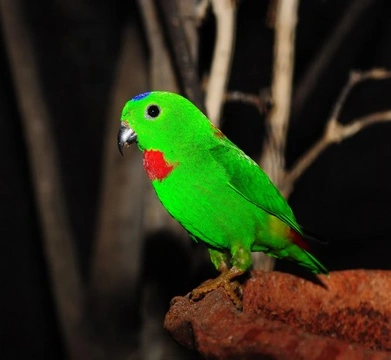
Blue-crowned Hanging Parrot Care and Facts Guide
The Blue-crowned Hanging Parrot (Loriculus galgulus) is a striking member of the family of hanging parrots, native to Southeast Asia's lowland forests stretching from Thailand to Borneo. Also known as the sapphire crowned hanging parrot, it is among the most recognized species of its kind.
These birds measure about 12-14.5cm in length and weigh approximately 28 grams. Adult males display a bright green plumage with a distinctive dark blue crown patch, a red throat, a yellow band across the lower back, and a red rump. Their beak is black and eyes dark brown. Females tend to have duller green feathers, with minimal or no blue crown, no red throat patch, and lack the yellow on the lower back. Juveniles resemble females but feature a dull green colour, little to no blue crown, a green rump edged with red feathers, and a yellowish-brown bill that darkens with maturity.
Habitat and Behaviour
In the wild, these parrots inhabit forests, forest edges, swamps, mangroves, bamboo thickets, secondary vegetation, plantations, parks, and gardens. Often, they live in pairs or small family groups outside the breeding season, camouflaging using their green plumage. At feeding spots, especially in the evening, they can gather in large groups, sometimes over 150 birds roost together. Their calls are shrill and squeaky when in flight, while foraging calls consist of sharp two-syllable notes.
Keeping Blue-crowned Hanging Parrots as Pets
Although rarely kept in the UK, these parrots are popular pets in Malaysia. They are kept in wide-barred pumpkin-shaped cages that allow their watery droppings to fall through, though such cages can be cramped; a more spacious aviary with plastic backdrops is preferable to maintain hygiene. Notably, they roost upside down—a unique behaviour thought to deter nocturnal predators, earning them the nickname "bat parrot" in some regions. Reluctance to hang upside down may indicate illness.
In the UK climate, they can spend warmer months outdoors but require heated aviaries or to be brought indoors during colder weather. They benefit from well-planted enclosures to use plant moisture for bathing, as they typically do not take baths in water bowls. They generally coexist well with finches, doves, and similarly sized parrots such as grass parakeets. Frequent beak cleaning on perches means perches may need regular maintenance.
Active and agile, Blue-crowned Hanging Parrots enjoy flying and climbing throughout their enclosure, and with time can become tame and trusting to their keepers. They are relatively quiet, making them suitable pets and aviary birds. To help manage overgrown nails, wide-diameter wooden perches from hardwoods like hawthorn aid in natural nail wear. Due to their messy droppings, careful hygiene is crucial to prevent fungal infections, with prompt treatment important if needed.
Feeding and Nutrition
Wild Blue-crowned Hanging Parrots feed on seeds, fruits, and insects, also visiting flowering trees for nectar, which sometimes labels them as pests in orchards and plantations. Favourite wild fruits include the protein-rich rambutan, similar to lychee.
In captivity, their diet should include buds from plants such as buddleia, a variety of seed mixes, and fresh fruits like pomegranates, grapes, cucumbers, figs, apples, berries, bananas, and pears. Soaking seeds to soften them is often preferred. They also benefit from protein-rich foods such as egg food and hardboiled egg yolks. For nectar feeding, an artificial nectar and pollen mixture designed for lorikeets should be provided in specialised nectar bottles to avoid spoiling feathers.
Breeding Tips
Males perform courtship displays involving rapid perch running, head bobbing, raising red throat and rump feathers, accompanied by a buzzing call. Nesting typically occurs in tree cavities in the wild; in captivity, nest boxes suitable for lovebirds or larger that allow nest decoration are used. The female lays three to four eggs, incubated around 21 days with chicks fledging at roughly 35 days. Breeding is considered challenging and requires patience.
Feeding of chicks varies between pairs—some provide seeds, others live food such as mealworms—so offering both is recommended. The male supplies food to the female during incubation. Occasionally, non-breeding birds help rear the young, identifiable by their immature feathers that develop adult plumage at two to three years.
Responsible Ownership and Welfare
Prospective keepers should ensure they can provide appropriate spacious, hygienic housing with temperature control in colder months, a varied diet catering to their nectarivorous needs, and vigilant health care to prevent fungal infections and nail overgrowth. Observing natural behaviours such as upside-down roosting is a good health indicator, while taming should be gentle and patient to build trust.
Ensuring birds are sourced from reputable breeders or rescues helps support ethical pet ownership. Offering environmental enrichment mimicking their natural habitat improves welfare, such as live plants for bathing moisture and climbing opportunities.
As social birds, Blue-crowned Hanging Parrots thrive with companionship, either as pairs or in small groups, depending on owner capability. Their quiet demeanor and manageable size make them uniquely rewarding pets for enthusiasts who appreciate their distinctive behaviour and striking appearance.
For those interested in obtaining pet birds, exploring birds for sale through trusted sources is recommended to avoid impulsive or unsuitable acquisitions.
Conclusion
The Blue-crowned Hanging Parrot is a delightful and distinctive species requiring specialised care and attentive management. By understanding their habitat, behaviour, dietary needs, and health requirements, owners can provide an enriching environment for these charming birds. Their unique upside-down roosting and gentle nature offer a fascinating pet experience, rewarding those who commit to their wellbeing.



